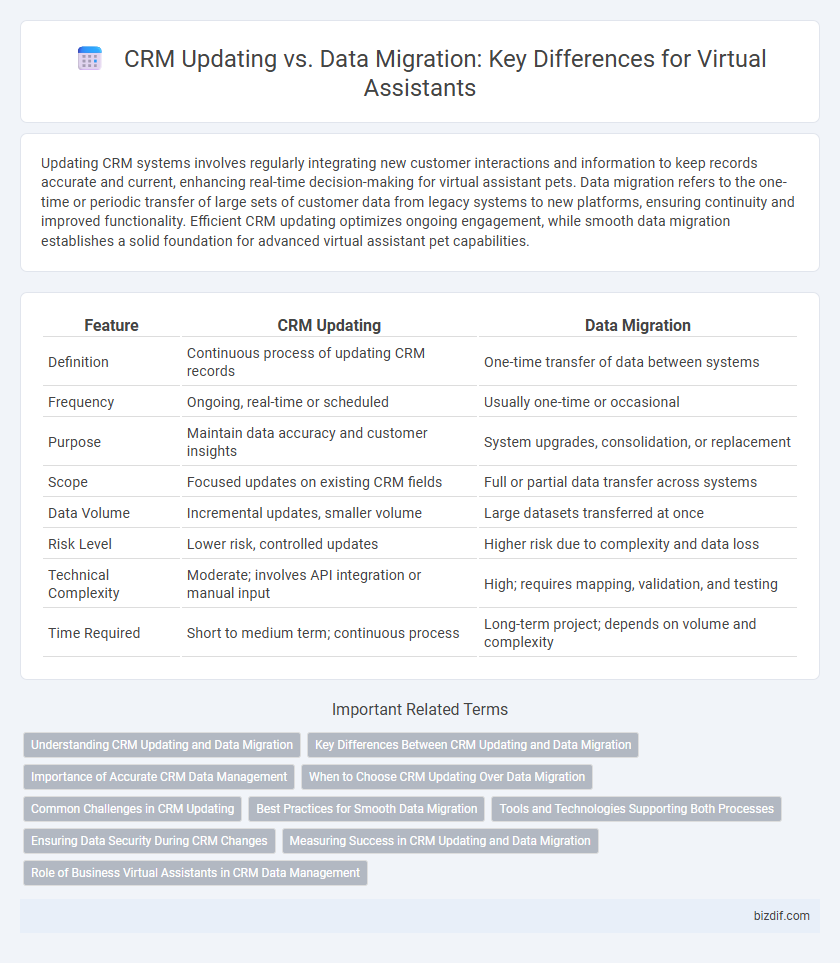Updating CRM systems involves regularly integrating new customer interactions and information to keep records accurate and current, enhancing real-time decision-making for virtual assistant pets. Data migration refers to the one-time or periodic transfer of large sets of customer data from legacy systems to new platforms, ensuring continuity and improved functionality. Efficient CRM updating optimizes ongoing engagement, while smooth data migration establishes a solid foundation for advanced virtual assistant pet capabilities.
Table of Comparison
| Feature | CRM Updating | Data Migration |
|---|---|---|
| Definition | Continuous process of updating CRM records | One-time transfer of data between systems |
| Frequency | Ongoing, real-time or scheduled | Usually one-time or occasional |
| Purpose | Maintain data accuracy and customer insights | System upgrades, consolidation, or replacement |
| Scope | Focused updates on existing CRM fields | Full or partial data transfer across systems |
| Data Volume | Incremental updates, smaller volume | Large datasets transferred at once |
| Risk Level | Lower risk, controlled updates | Higher risk due to complexity and data loss |
| Technical Complexity | Moderate; involves API integration or manual input | High; requires mapping, validation, and testing |
| Time Required | Short to medium term; continuous process | Long-term project; depends on volume and complexity |
Understanding CRM Updating and Data Migration
CRM updating involves regularly refreshing and enhancing customer data within the existing system to ensure accuracy and relevance, while data migration refers to the complex process of transferring large volumes of customer information from one CRM platform to another. Effective CRM updating optimizes data quality for improved customer interactions, whereas data migration requires thorough planning and validation to prevent data loss and maintain system integrity. Understanding these differences is crucial for businesses aiming to leverage virtual assistants to streamline customer relationship management and ensure seamless data transitions.
Key Differences Between CRM Updating and Data Migration
CRM updating involves the continuous process of enhancing and maintaining existing customer records within the same system, ensuring data accuracy and relevance for improved decision-making. Data migration refers to the one-time transfer of data from an old CRM or external source to a new CRM platform, emphasizing data integrity and compatibility during the transition. Key differences include the frequency of the process, with CRM updating being ongoing and data migration being a singular, often complex project, as well as the scope, where updating modifies current data while migration moves entire datasets between systems.
Importance of Accurate CRM Data Management
Accurate CRM data management is crucial for maintaining customer relationships and streamlining business operations, ensuring virtual assistants can provide personalized and timely interactions. Efficient CRM updating prevents data redundancy and errors, while data migration requires careful validation to preserve data integrity during system transitions. Reliable CRM data empowers virtual assistants to enhance customer engagement and drive informed decision-making.
When to Choose CRM Updating Over Data Migration
Choose CRM updating over data migration when existing customer data requires regular enhancement and real-time accuracy without system overhaul. CRM updating is ideal for incremental improvements, integrating new data seamlessly while maintaining workflow continuity across sales, marketing, and support teams. This approach minimizes downtime and preserves data integrity, contrasting with data migration's extensive process suited for platform changes or major system upgrades.
Common Challenges in CRM Updating
Common challenges in CRM updating include data inconsistency, integration issues with existing systems, and user adoption resistance. Ensuring real-time synchronization and maintaining data accuracy during frequent updates can strain system performance and lead to operational disruptions. Addressing these challenges requires robust validation protocols and seamless integration strategies to optimize CRM functionality.
Best Practices for Smooth Data Migration
Efficient data migration in CRM systems requires thorough planning, including data cleansing to eliminate duplicates and ensure accuracy. Establishing clear mapping rules between old and new data structures prevents loss or misinterpretation of information during the transfer. Performing rigorous testing in a sandbox environment prior to full migration minimizes disruptions and ensures seamless integration for virtual assistant functionalities.
Tools and Technologies Supporting Both Processes
CRM updating relies on tools like Salesforce Lightning, HubSpot, and Zoho CRM, which facilitate real-time data synchronization and automated workflows for seamless customer relationship management. Data migration utilizes ETL platforms such as Talend, Informatica PowerCenter, and Microsoft SQL Server Integration Services (SSIS) to extract, transform, and load large volumes of data between legacy systems and new CRM environments. Both processes benefit from APIs, cloud-based platforms, and AI-powered analytics tools that enhance data accuracy, integration efficiency, and operational scalability.
Ensuring Data Security During CRM Changes
Ensuring data security during CRM updates and data migration involves robust encryption protocols and strict access controls to protect sensitive customer information from unauthorized access or breaches. Implementing automated validation tools and real-time monitoring systems helps maintain data integrity and quickly identify discrepancies during the transition. Regular backups and compliance with data protection regulations such as GDPR enhance security by providing recovery options and minimizing legal risks throughout the CRM change process.
Measuring Success in CRM Updating and Data Migration
Measuring success in CRM updating involves tracking data accuracy, user adoption rates, and system performance improvements to ensure enhanced customer relationship management. Data migration success is evaluated by the completeness of transferred data, minimal downtime, and seamless integration with existing workflows. Key performance indicators such as error rates, data integrity, and post-migration user satisfaction provide critical insights into project effectiveness.
Role of Business Virtual Assistants in CRM Data Management
Business virtual assistants streamline CRM data management by automating real-time updates, ensuring accurate and consistent customer information across platforms. They reduce manual effort in data entry and validation, enhancing data integrity and enabling timely decision-making. By facilitating seamless CRM data migration, these assistants minimize errors and downtime during system transitions, supporting business continuity.
CRM updating vs Data migration Infographic

 bizdif.com
bizdif.com